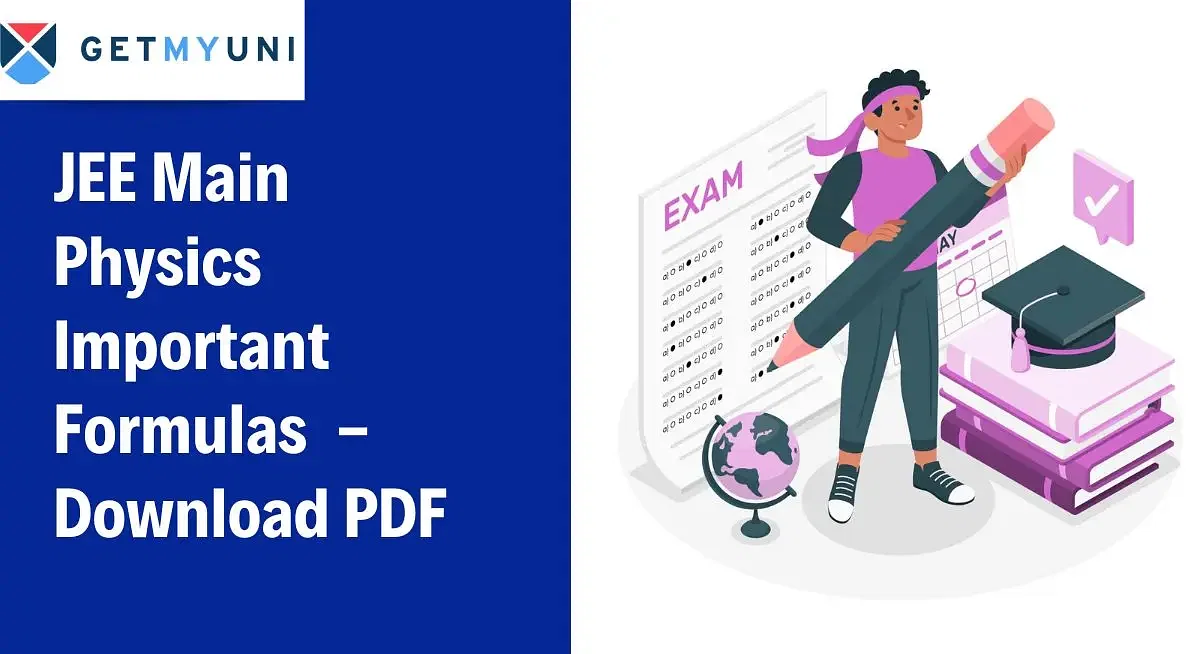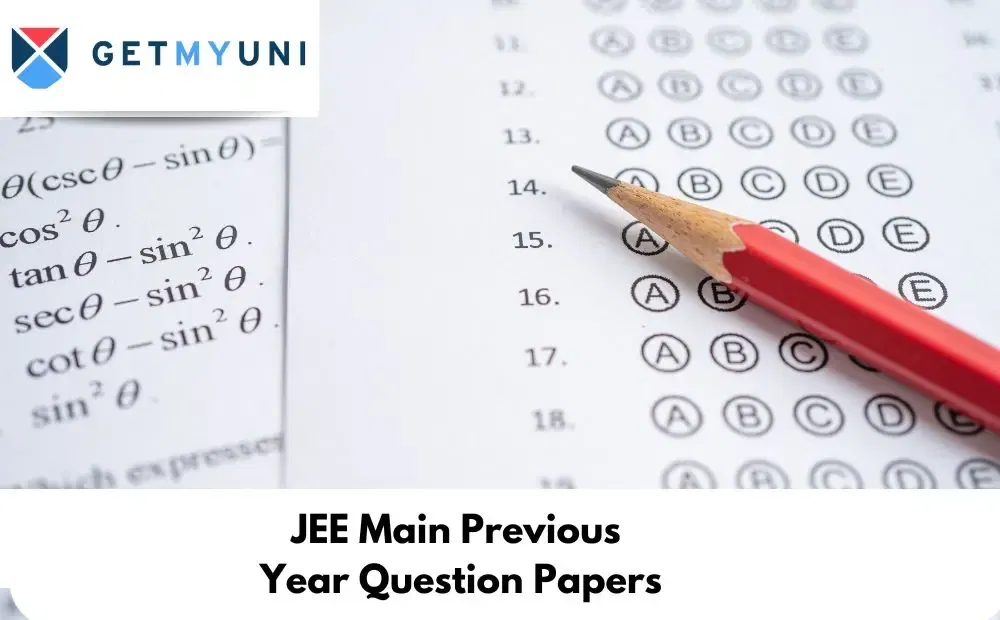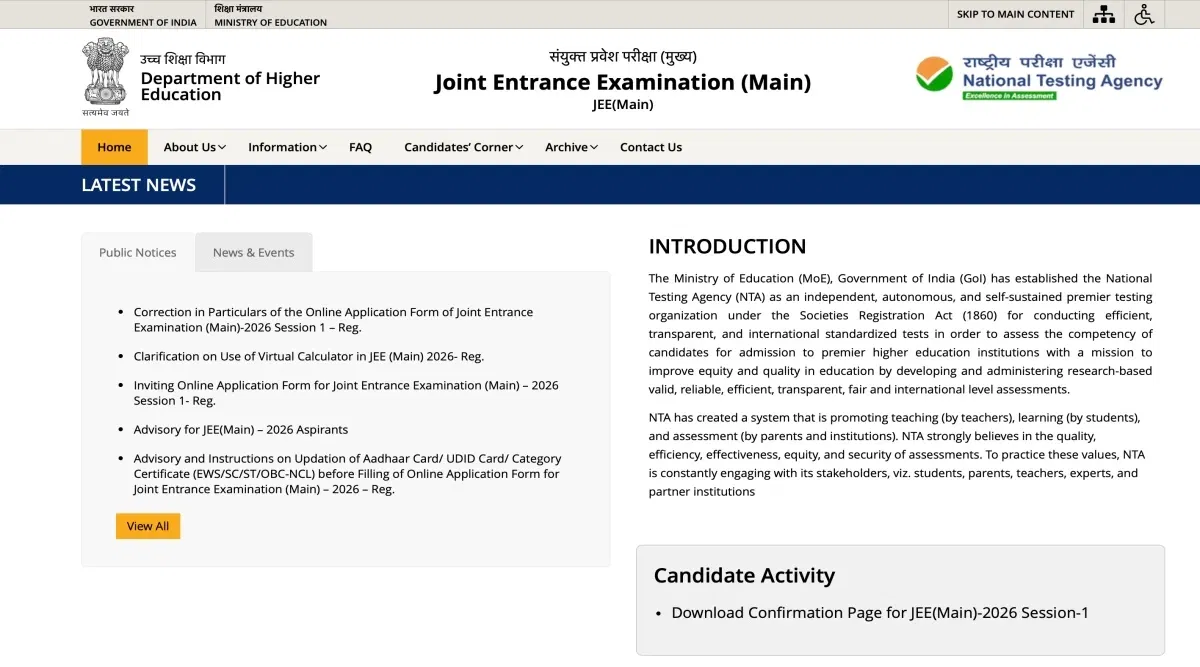Learning about the JEE Main Physics important formulas 2026 is crucial to scoring good marks in JEE Mains. Some crucial formulas are covered under topics like Laws of Motion, Kinematics, Work, Energy & Power, Gravitation, Thermodynamics etc.
Table of Contents
JEE Main Physics important formulas 2026 cover the Relative Motion Formula, Gravitation Formula, Current Electricity Formula, and Centre of Mass Formula, among others. Aspiring students must get familiar with these common Physics formulas to achieve high scores in the JEE Main exam.
JEE Main is one of the most competitive exams in India. Students cannot afford to miss even a single topic from any of the subjects. JEE Main Physics important Formulas 2026 will help students not only prepare for exams effectively but also solve complex problems seamlessly.
You must practice JEE Main Physics Important Formulas 2026 consistently to get good scores in the JEE Main examination.
JEE Main Physics Important Formulas 2026: Download PDF
Apart from some of the most common formulas in JEE Main Physics syllabus, you must also go through chapter-wise formulas for the JEE Main Physics paper. Students can find the JEE Main Physics important formulas 2026 PDF tabulated below:
| JEE Main Physics Important Formulas 2026 PDF | Click Here |
Also Read: JEE Main Important Formulas 2026
Chapter-Wise JEE Main Physics Important Formulas 2026
Covering the entire JEE Main syllabus is one of the most important tasks for you, if you are appearing for the exam. The syllabus is not only vast enough for students to study within a short period of time, but to master the JEE Main Physics syllabus, you should know the set of important formulas that will help them get good scores.
You can go through the JEE Main Physics important formulas 2026 that are mentioned below:
Kinematics Formulas:
- v=dr/dt and a=dv/dt and a=d2r/dt2
- For 1-D Motion: a=v(dv/dx)
- v=u+at, s=ut+(1/2)at2 and v2=u2+2as
- sn-sn-1=u+(a/2)(2n-1)
- v (relative)=v (actual)-v (reference)
- Projectile Motion Initial Horizontal Velocity is ux=u
- Projectile Motion Initial Vertical Motion is uy=u
- Velocity at any instant of a Projectile Motion is v=u i+(u-gt) j
- Horizontal Distance at any time is x=ut
- Time of Flight is T=2u/g
- Maximum Height of the Projectile is H=u22/2g
- Horizontal Range is R=u22/g
- Equation of Trajectory is y=x-gx2/( 2u22 )
- Time of Flight for the Horizontal Projection from a cliff is T=2h/g
- Horizontal Range for the Horizontal Projectile from a cliff is R=uT
- Angle of velocity at any instant for Horizontal Projection from a cliff is =(gt/u)
Newton's Laws of Motion:
- Fundamental Forces of Nature are the Gravitational Force, the Electromagnetic Force, the Weak Nuclear Force, and the Strong Nuclear Force.
- F=dp/dt and F=ma is mass is constant
- Impulse j=Ft in the discrete case and j=t1t2F dt
- Acceleration of Pulley when both masses are downwards is a=| m1-m2 |g/( m1+m2 )
- Tension in the string of a Pulley System when masses are downwards is T=2m1m2g/( m1+m2 )
- Man in a lift going upwards: Fnet=m(g+a)
- Man in a lift going upwards: Fnet=m(g-a)
- Centripetal Force is F=mv2/r=m2r
- Static Frictional Force is f=sN, where N is the Normal Force on the object
- Kinetic Frictional Force is f=kN, where N is the Normal Force on the object
- Angle of Friction is = mg sin θ
- Block sliding on an incline with angle of Repose: f=mg and N=mg
Also Read: JEE Main Physics High Weightage Chapters 2026
Work, Energy, and Power Formulas:
- Work Done W=Fd when distance is non-variable and W=abFs when distance is variable
- Kinetic Energy K=mv2/2
- Potential Energy U=mgh+h, where h is the height from the reference line
- Conservative Force F= -U, in 1-D, it is F= -dU/dx
- Work Energy Theorem: W (all forces)=K=Kf-Ki
- Power P=Fv or P=W/t
Circular Motion:
- Time Period T=1/f is the reciprocal of Frequency
- =l/r, =d/dt=2/T=2f and =d/dt
- =v/r or v=r
- Net acceleration a=r+v and a=( 2r )2+( r )2
- Maximum velocity without skidding is v=Rg
- Maximum velocity for a banked road is v= (+1- )Rg
- Bending of a Cyclist: vr*g*tan
- The condition to complete the vertical circle is u5gR
- The condition for Oscillation is u2gR, and the Tension in the string is T=mg+mv2/R
- The condition for leaving the path is 2gR < u < 5gR
Also Read: JEE Main Physics Question Papers with Answer Keys PDF
Center of Mass:
- The Center of Mass along the x-axis is XCM=(1/M)i=1nmixi, where M is the total mass
- The Center of Mass along the y-axis is YCM=(1/M)i=1nmiy,i where M is the total mass
- The Center of Mass along the z-axis is ZCM=(1/M)i=1nmi,zi where M is the total mass
- The Center of Mass for Continuous Distribution is RCM=(1/M)r dm
- If the total mass is M and a small part of mass m is remo,ved then the Center of Mass is given by XCM=(Mx-m)/(M-m), YCM=(My-m)/(M-m) and ZCM=(Mz-m)/(M-m)
- The Center of Mass when the object is moving with some velocity is vCM=(1/M)i=1nmivi
- The Center of Mass when the object is moving with some acceleration is aCM=(1/M)i=1nmiai
- Coefficient of Restitution is e=(v2-v1)(u1-u2)
- Law of Conservation of Linear Momentum: i=1nmiui=j=1nmjvj
- Loss of Kinetic Energy in inelastic collision is K=(1/2M)[ m1m2(1-e2)(u1-u2)2 ]
- Law of Conservation of Linear Momentum for Oblique Collision is i=1nmiui=j=1nmjvj
- Thrust Force on a Rocket is vr(-dm/dt)
- Velocity of a Rocket at any time is v=u-gt+v1(m0/m)
Gravitation:
- Newton’s Law of Gravitation is F=Gm1m2/R2 where G6.67*10-11Nm2/kg2
- Gravitational Field is GM/R2
- Gravitational Field outside a Spherical Shell is -GM/r2 where r>R
- Gravitational Field on the Surface of the Spherical Shell is -GM/R2
- Gravitational Field inside the Spherical Shell is 0
- Gravitational Field outside a Solid Sphere is -GM/r2 where r>R
- Gravitational Field inside a Solid Sphere is -GMr/R3 where r < R
- Acceleration due to gravity is g=GM/R2
- Acceleration due to gravity at height h above the surface is gh=g(1-2h/R) when h <<< R
- Acceleration due to gravity at depth d from the surface is gd=g(1-d/R)
- Acceleration due to gravity at latitude is g=g-2R2
- Gravitational Potential due to a point mass is V= -GM/r
- Gravitational Potential inside a Spherical Shell is 0
- Gravitational Potential outside the Spherical Shell is V= -GM/r where r>R
- Gravitational Potential inside a Solid Sphere is V= -GM(3R2-r2)/2R3 where r < R
- Potential of a thin ring on the axis at a distance r is V= -GM/R2+r2
- Escape Velocity from a planet is v=2GM/R
- Orbital Velocity of a satellite is v=GM/r where r>R
- Time Period of a satellite is T=2*rr/GM
- Potential Energy of a point mass at a distance r from the center of the object is U= -GMm/r
- Kinetic Energy of a satellite is K=GMm/2r
- Mechanical Energy of a satellite is E= -GMm/2r
- Kepler’s 3rd Law of Planetary Motion is T2=ka3, where a is the length ofthe semi-major axis
Also Read: How to Study Physics for JEE Main 2026?
The JEE Main Physics important formulas carry a good weightage in the JEE Main Physics paper. Thus, you must thoroughly understand and revise these formulas to be able to score well in the exam. Moreover, you will be easily able to solve complex problems in the exam by learning the physics formulas under the JEE Main exam.























POST YOUR COMMENT